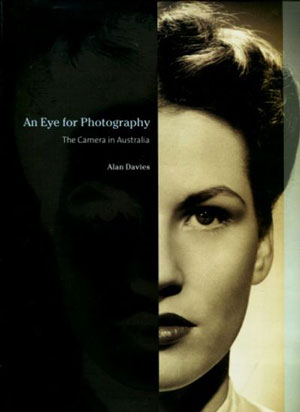
- Free Article: No
- Contents Category: Photography
- Review Article: Yes
- Article Title: Charting a Meaningful Path
- Online Only: No
- Custom Highlight Text:
For nearly 100 years before any public art gallery entered the field, the main institutional collectors of Australian photography were state libraries. Primarily, they bought photographs for their informational value; the maker of the image was of relatively little concern to them. What mattered was the subject: what the photograph told the interested viewer about the people, places, and events of an evolving nation.
- Book 1 Title: An Eye For Photography
- Book 1 Subtitle: The camera in Australia
- Book 1 Biblio: Miegunyah Press, $69.95 hb, 234 pp
- Book 1 Cover Small (400 x 600):

- Book 1 Cover (800 x 1200):

Australia’s state libraries still continue their collecting role, adding regularly to the many millions of photographs that already form a vast visual archive. Until recently, the extent of these resources was often impenetrable, unknown to all but those who cared for the collections. Now, as the interest in photography continues to grow, libraries are responding by making the collections more accessible in various ways. The treasures of Australia’s libraries are gradually being revealed, assisted considerably by information technologies, but, just as importantly, by the intelligent selection of images for publication or exhibition from those who work with the collections. The result is a revelation, bringing new and often remarkable photographs to our attention; shifting our perceptions of visual and social history; and allowing new interpretations of the history of Australian photography.
An Eye for Photography, one of the latest contributions to this field, offers a welcome insight into the photography collection of the State Library of New South Wales (SLNSW). It is based on the insider knowledge of Alan Davies, the curator of the photography collection since 1989, and a researcher whose own ‘eye’ for the medium is certainly one of SLNSW’s treasures. One of Davies’ previous books, The Mechanical Eye in Australia (1985, with Peter Stanbury), is still among the small library of essential items for any serious devotee of nineteenth-century Australian photography. While that book succeeded in its encyclopedic aim to list the working dates of every nineteenth-century Australian photographer, the intention in An Eye for Photography is quite different.
Part of the problem (and delight) of the SLNSW collection is that it contains over one million photographs. Charting a meaningful path through this collection represents a distinct and, no doubt, daunting challenge. Davies has opted for an approach that is broadly thematic but strongly informed by an emphasis on technical developments. As the blurb notes, ‘[the] development of photography in Australia is both a reflection and an intriguing record of technological, social and artistic change …’ In descending order of importance, it is these three ways of approaching the medium that informs Davies’ selection of 160 photographs from the collection.
Davies has ambitious aims – indeed, the book is subtitled The Camera in Australia – and, given the diversity and extent of the material he has to cover, the book requires a rigorous theoretical underpinning to hold it together. Unfortunately, perhaps in trying to accommodate readers with many potential interests or perhaps overwhelmed by the wealth of visual material, the structure of Davies’ chapters feels weak at times. The problem may be inherent to large library collections that comprise a diversity of photographic material not easily accommodated by the usual technical or art historical approaches we would commonly apply to them. Davies’ difficulty in charting a meaningful path through the collection is certainly less apparent with nineteenth-century photography, where he is clearly more at ease with the material. However, with the exception of an interesting section on colour photography from the 1950s and 1960s, his approach poorly serves contemporary photography, with the last twenty years almost entirely compacted into a discussion of digital imagery.
While the structure of An Eye for Photography may feel less than satisfying, the considerable joy of this book lies in its details. Each beautifully printed photograph and its pithily written caption offers a glimpse into the people or history of a period in Australian life, if not an analysis of the image itself. Often, the most intriguing photographs are portraits taken both by the well-known and the amateur alike. Witness, for instance, the fabulous Madame Franzina who came to Sydney in 1876 as a bicycle performer; or the rough group of miners standing alongside an incongruously fluffy poodle in the dusty main street of Gulgong in 1872. Charming as these moments are, perhaps the most revealing photographs are those that suggest larger stories. Fred Hardie’s photograph of Aboriginal children in a mission classroom at Yarrabah in 1893, for instance, is a painful and intensely disquieting study of social attitudes. Likewise, the photograph by Lethington Maitland of an evicted family standing stoically with their pile of belongings outside their Redfern house in 1934 encapsulates something of the personal tragedy involved in the Depression years.
Photographs such as these reveal the value of Australian photography in capturing and interpreting history. The reproduction of many previously unseen images can surely only add to the already strong interest in the medium. The care and attention given to this book’s production offer an indication of the high value that the SLNSW quite rightly places on its archives. While An Eye for Photography may not offer a totally satisfying methodology for considering the collections it surveys, it succeeds in whetting our appetite. With so much material evidently available for public viewing, the best result of a book like this is to inspire others to turn their own eyes to photography.


Comments powered by CComment